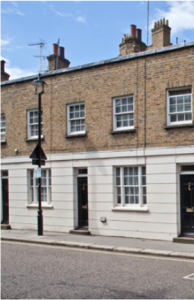
Enviroform Insulation in Central London Retrofit
Enviroform Solutions played a key role in the refurbishment process and upgrade of two historic properties to Enerphit standard in Passmore Street in Belgravia, Westminster, central London. Enerphit Standard is the Passive House Institutes benchmark for renovation.
The work was at the forefront of efforts by Grosvenor Great Britain and Ireland to reduce the carbon footprint across its extensive property portfolio. It is trying to reduce its carbon footprint by 38% and the Passmore street properties are the first in a series of planned refurbishments.
Passive House buildings maintain pleasant indoor temperatures year round with extremely low energy demands. Such buildings require careful design, thorough planning and meticulous execution.
Grosvenor have chosen the Passive House Standard because they believe it offers more practical benefits – it focuses on energy efficiency, building fabric and indoor air quality. The key target is to keep these buildings viable as residential or office accommodation for the next 300 years.
Aerogel Insulation
In completing the upgrade, the architect, Sturgis Carbon Profiling (SCP) specified Aerogel insulation supplied by Enviroform Solutions. The exterior façade of the historic properties had to be maintained so internal wall insulation was the only viable option.
This meant losing some of the internal floor area and with that, potentially a loss of rental income because of decreased space. This can amount to a significant sum over time. Aerogel being ultra thin and ultra light was the obvious solution to this issue.
Liam Brown of Enviroform Solutions explained: “Aerogel’s breathable qualities help reduce the risk of condensation. The exterior walls were rendered to prevent rain and moisture getting into the building fabric. The design also took account of thermal bridges – points in the building where cold structures penetrate the insulation layer and cause loss of heat and/or build up of moisture and condensation potentially leading to damp and mould.”
He continued: “ One of the lessons on embarking on this type of refurbishment is to source the right builder. A typical competitive tender would have resulted in a builder who would try and cut corners right until the death.’ And what is required in these projects is a patient approach that shows understanding of the subtle issues involved.”
Liam added: “The Passmore Street properties are now the first privately rented Enerphit projects in London. Potentially this is the way to proceed but there needs to be a lot more understanding of the issues involved amongst the building community. Property owners and consumers also need to understand the benefits of a passive house in terms of health and saving costs.”
“There will be a premium to pay in adopting this approach – the initial costs on these research retrofits were indeed more expensive that typical whole building upgrades.”
“The aim would be to get that premium down to around 5% and then recover that cost and more over the life of the building through savings in heat and eliminating problems caused by damp and mould. The refurbished buildings will see a reduction in the amount of their CO2 emissions over a 60 year life cycle.”
He concluded: “The evidence is there to show that this can be the way to go forward in refurbishing and preserving older buildings. With the current property market in Ireland its is clear that the energy of the building trade over the coming years will be in refurbishing and retrofitting older properties that present challenges of their own. We need to understand these issues and plan accordingly.”
